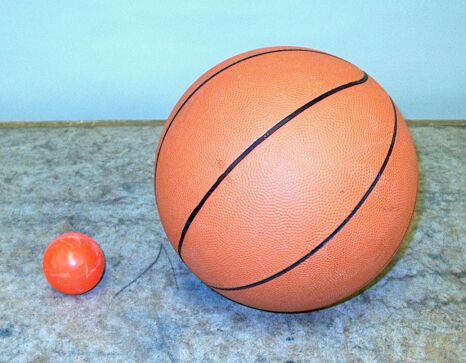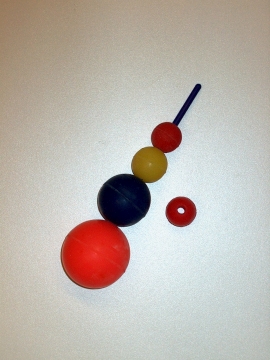 |
 |
A video of this demonstration (basketball and bouncy ball only) is available at this link.
From chest height, drop separately the basketball and the small orange ball, calling attention to their rebound heights. Then from the same height, drop the basketball with the small ball placed on top of it. Note that, relative to the height to which each ball bounced when you dropped them individually, the basketball does not bounce nearly as high, and the small orange ball bounces much higher. Also available is an “Astro Blaster,” shown above at right. This is a set of rubber balls on a rod, which is embedded in the largest ball. All the other balls are free to move, but only the smallest one can leave the rod. Holding the top of the rod, with the balls hanging below, release it. When the unit bounces back from the floor, the smallest ball goes flying up.
The page for demonstration 24.12 -- Elastic and inelastic collisions on the air track, describes what happens in elastic collisions in a variety of cases. It shows how, by satisfying the conservation of both momentum and kinetic energy for two objects that undergo an elastic collision, one can derive equations for the velocities of the two objects after the collision, in terms of their initial velocities and their masses. These equations are:
v1f = [(m1 - m2)/(m1 + m2)]v1i + [2m2/(m1 + m2)]v2i, and v2f = [2m1/(m1 + m2)]v1i + [(m2 - m1)/(m1 + m2)]v2i, where v1i, v1f and m1 are, respectively, the velocity of object 1 before and after collision, and the mass of object 1, and v2i, v2f, and m2 are, respectively, the velocity of object 2 before and after collision, and the mass of object 2. These equations will be useful for showing what happens in this demonstration.
When you drop either the basketball or the small orange ball on the floor, it undergoes an elastic collision with the floor. The floor, not to mention the building of which it is a part, or the earth on which the building sits, is so much more massive than either ball, that in its collision with the floor, each ball has its momentum reversed, and bounces back with a velocity that is essentially equal to and opposite the velocity it had just when it struck the floor. The collision is not perfectly elastic, so some kinetic energy is lost, and the rebound velocity is somewhat smaller, but each ball bounces most of the way back to the height from which you dropped it. If we call either ball mass 1, and the floor mass 2, then the ball strikes the floor at velocity v1i, and v2i = 0. The first equation gives v1f. Since m2 ≫ m1, the bracketed part of the first term approaches -1. Since v2i = 0, the second term equals zero, and v1f ≈ -v1i.
Now comes the interesting part, which is what happens when you drop the two balls together, with the small one on top of the large one. When the basketball returns from its collision with the floor, it collides with the small ball. Let us call the basketball mass 1, and the velocity at which it leaves the floor v1i. When the basketball collides with the small ball, which we will call mass 2, the small ball is traveling downwards at the same velocity that the basketball had when it struck the floor. Since the basketball left the floor at almost the same velocity at which it had struck the floor, we have v2i ≈ -v1i. The basketball is about 5.5 times the mass of the small ball, so we will write m1 = 5.5m2. Putting these into the first equation gives (for the basketball) v1f = [(4.5m2)/(6.5m2)]v1i + [2m2/(6.5m2)](-v1i), or v1f = 0.69v1i - 0.31v1i, or v1f = 0.38v1i. Thus, after colliding with the small ball, the basketball keeps rising, but at only about 38 percent of the velocity it had before the collision. This reduces its kinetic energy to 0.382, or 0.15, times the kinetic energy it had before the collision, and reduces the maximum height it reaches to 0.15 times what it should have been without the collision with the small ball.
For the small ball, we have, v2f = [(11m2)/(6.5m2)](-v2i) + [(-4.5m2)/(6.5m2)]v2i, or v2f = (-11/6.5)v2i - (4.5/6.5)v2i, or v2f = (-15.5/6.5)v2i = -2.4v2i. Thus the small ball flies upwards from the collision at 2.4 times the speed at which it was falling just before the collision. This means that it has about -2.42, or about 5.7, times the kinetic energy that it had just before collision. It thus has roughly 5.7 times the kinetic energy it should have had if it had struck the floor and bounced back. This means that the maximum height it reaches is about 5.7 times the height from which it was dropped. (We are ignoring the extra height added by the basketball, but this is relatively small.)
We must note that these calculations are for perfectly elastic collisions, so the results of the demonstration will differ from them slightly. In a perfectly elastic collision, both total momentum and total kinetic energy should be conserved, which is why we set total momentum after collision equal to total momentum before collision, and total kinetic energy after collision equal to total kinetic energy before collision, to arrive at the equations that we used for our calculations. In reality, as noted above, the collisions between the balls and the floor (and each other) are not completely elastic; some kinetic energy is lost as heat during the deformation of the balls. In any collision, total momentum is always conserved, as is total energy.
The Astro Blaster works on the same principle, but the momentum exchange occurs in a series of collisions among four balls, each one less massive than the one that bounced up to collide with it. Hold the Astro Blaster by the tip of the rod, with the balls hanging below, and release it. When it bounces back from the floor, the smallest ball flies up to a great height.